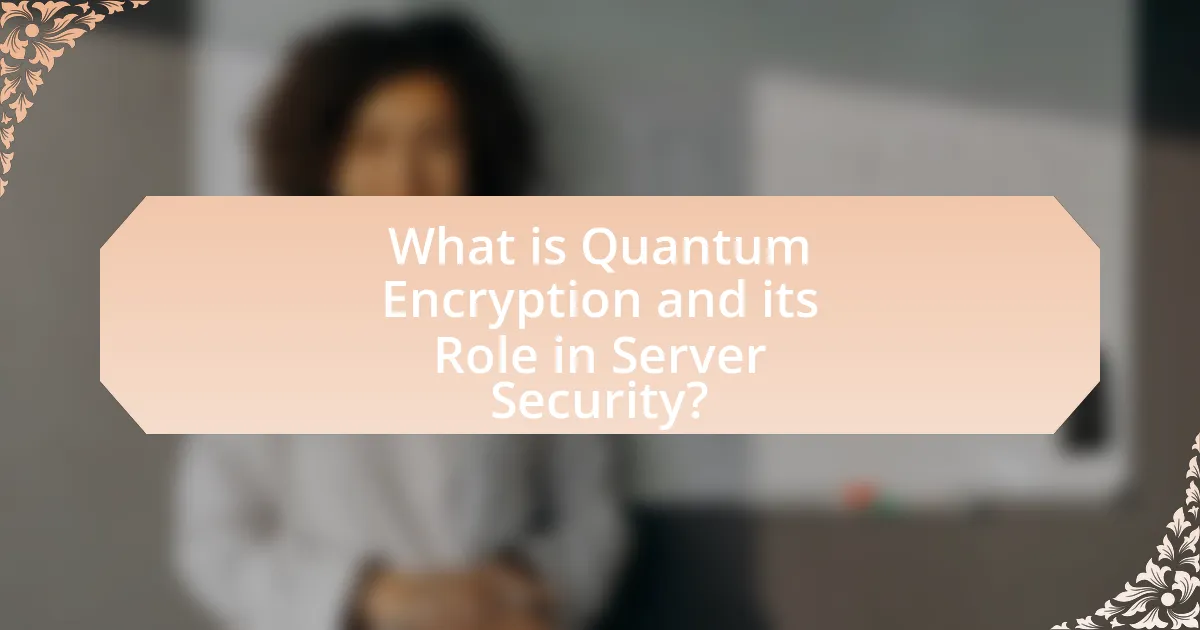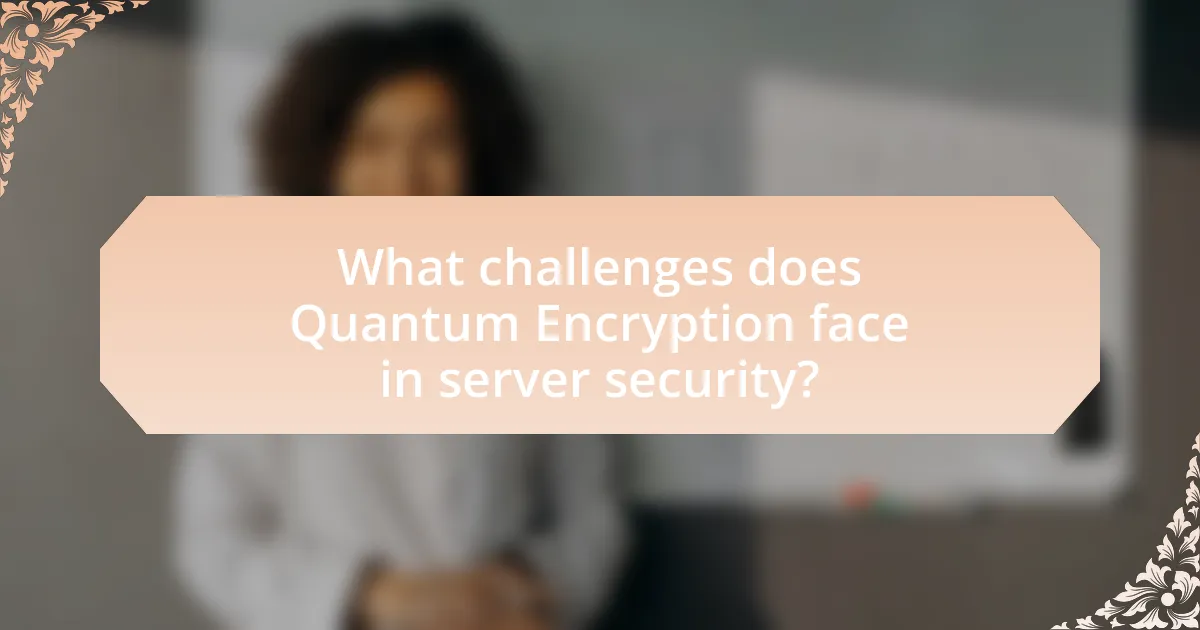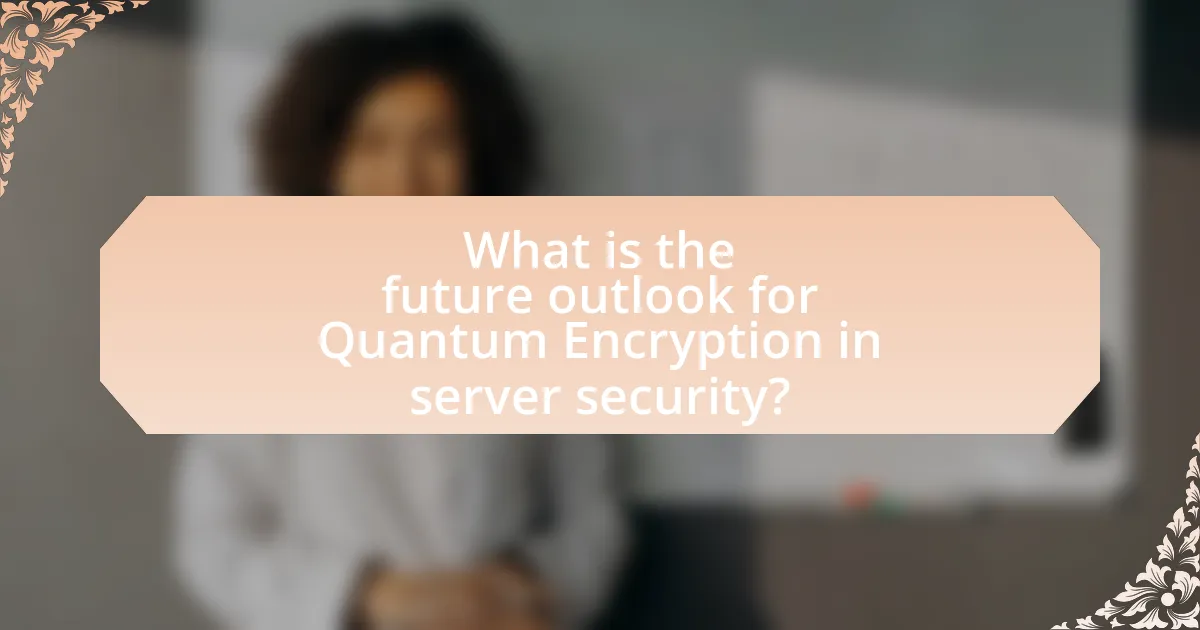Quantum encryption is a cutting-edge technology that leverages the principles of quantum mechanics to enhance server security through methods such as quantum key distribution (QKD). This article explores the fundamental differences between quantum and traditional encryption methods, highlighting the key principles that make quantum encryption theoretically unbreakable. It discusses the potential applications across various industries, the challenges and technical limitations faced in its implementation, and the regulatory landscape surrounding its adoption. Additionally, the article examines the future outlook for quantum encryption, including anticipated breakthroughs and best practices for organizations looking to integrate this advanced security measure into their existing systems.

What is Quantum Encryption and its Role in Server Security?
Quantum encryption is a method of securing data using the principles of quantum mechanics, primarily through quantum key distribution (QKD). QKD enables two parties to generate a shared, secret random key, which is theoretically secure against eavesdropping due to the nature of quantum states. This technology plays a crucial role in server security by ensuring that data transmitted between servers remains confidential and tamper-proof, as any attempt to intercept the quantum keys would disturb the quantum states and alert the parties involved. The implementation of quantum encryption can significantly enhance the security of sensitive information, making it resilient against future threats posed by quantum computing, which could potentially break traditional encryption methods.
How does Quantum Encryption differ from traditional encryption methods?
Quantum encryption fundamentally differs from traditional encryption methods by utilizing the principles of quantum mechanics to secure data, specifically through techniques like quantum key distribution (QKD). Traditional encryption relies on mathematical algorithms and computational complexity to secure information, which can be vulnerable to advancements in computing power, such as those posed by quantum computers. In contrast, quantum encryption ensures that any attempt to intercept or measure the quantum keys alters their state, thus alerting the communicating parties to potential eavesdropping. This inherent property of quantum mechanics provides a level of security that is theoretically unbreakable, as demonstrated by the no-cloning theorem, which states that quantum information cannot be copied without detection.
What are the key principles of Quantum Encryption?
The key principles of Quantum Encryption include the use of quantum key distribution (QKD), the no-cloning theorem, and the principle of superposition. Quantum key distribution allows two parties to generate a shared, secret random key using the properties of quantum mechanics, ensuring that any eavesdropping attempts can be detected. The no-cloning theorem states that it is impossible to create an identical copy of an arbitrary unknown quantum state, which enhances security by preventing interception. The principle of superposition allows quantum bits (qubits) to exist in multiple states simultaneously, enabling more complex encryption methods and increasing the security of the transmitted information. These principles collectively provide a robust framework for secure communication in the context of server security.
Why is Quantum Encryption considered more secure?
Quantum encryption is considered more secure because it utilizes the principles of quantum mechanics to protect information. This method, particularly quantum key distribution (QKD), ensures that any attempt to eavesdrop on the communication will disturb the quantum states being transmitted, thereby alerting the parties involved. For instance, the BB84 protocol, developed by Charles Bennett and Gilles Brassard in 1984, demonstrates that the security of the key exchange relies on the fundamental properties of quantum particles, making it theoretically immune to computational attacks that threaten classical encryption methods.
What are the potential applications of Quantum Encryption in server security?
Quantum encryption can significantly enhance server security by providing unbreakable encryption through quantum key distribution (QKD). QKD allows two parties to generate a shared, secret random key, which is secure against eavesdropping due to the principles of quantum mechanics. This method ensures that any attempt to intercept the key will be detectable, thus maintaining the integrity of the communication. Additionally, quantum encryption can be applied to secure data transmission between servers, ensuring that sensitive information remains confidential even in the presence of advanced computational threats. The implementation of quantum encryption in server security is supported by ongoing research, such as the development of quantum networks that facilitate secure communication across vast distances, demonstrating its practical viability and future potential in safeguarding digital infrastructures.
How can Quantum Encryption enhance data protection in servers?
Quantum encryption enhances data protection in servers by utilizing the principles of quantum mechanics to secure data transmission against eavesdropping. This technology employs quantum key distribution (QKD), which ensures that any attempt to intercept the key used for encryption alters the quantum state of the data, thereby alerting the parties involved. For instance, the BB84 protocol, developed by Charles Bennett and Gilles Brassard in 1984, demonstrates how quantum bits (qubits) can be used to create secure keys that are theoretically immune to hacking. As a result, quantum encryption provides a robust defense against potential cyber threats, making it a critical advancement in server security.
What industries could benefit from implementing Quantum Encryption?
Industries that could benefit from implementing Quantum Encryption include finance, healthcare, telecommunications, and government. The finance sector requires robust security measures to protect sensitive data and transactions, making quantum encryption an ideal solution due to its ability to secure communications against potential quantum computing threats. In healthcare, patient data privacy is paramount, and quantum encryption can safeguard electronic health records from unauthorized access. Telecommunications companies can enhance the security of their networks and customer data through quantum encryption, which offers superior protection against eavesdropping. Lastly, government agencies can utilize quantum encryption to secure classified information and communications, ensuring national security against advanced cyber threats.

What challenges does Quantum Encryption face in server security?
Quantum encryption faces significant challenges in server security, primarily due to the need for robust infrastructure and the current limitations of quantum technology. The implementation of quantum key distribution (QKD) requires specialized hardware and secure channels, which can be costly and complex to integrate into existing systems. Additionally, the vulnerability of quantum systems to side-channel attacks and the potential for quantum computers to break classical encryption methods pose further risks. Research indicates that while quantum encryption offers enhanced security, its practical deployment is hindered by these technological and economic barriers, as highlighted in studies on quantum cryptography and its applications in cybersecurity.
What are the technical limitations of Quantum Encryption?
Quantum encryption faces several technical limitations, including the challenges of scalability, the requirement for specialized hardware, and vulnerability to certain types of attacks. Scalability issues arise because current quantum key distribution (QKD) systems are limited in the distance over which they can effectively operate, typically around 100 kilometers without the need for repeaters. Additionally, the need for specialized hardware, such as single-photon sources and detectors, complicates widespread implementation and increases costs. Furthermore, quantum encryption is susceptible to attacks like the photon number splitting attack, which can compromise security if not properly mitigated. These limitations hinder the practical deployment of quantum encryption in server security applications.
How do current technological advancements impact these limitations?
Current technological advancements significantly enhance the capabilities of quantum encryption, thereby addressing limitations in server security. For instance, developments in quantum key distribution (QKD) allow for secure communication channels that are theoretically immune to eavesdropping, as any attempt to intercept the quantum keys alters their state, alerting the parties involved. Research by the University of Science and Technology of China demonstrated a QKD system over 4,600 kilometers, showcasing the potential for long-distance secure communication. Additionally, advancements in quantum computing are driving the need for stronger encryption methods, as traditional algorithms may become vulnerable. The integration of quantum-resistant algorithms into existing systems is being explored to mitigate these risks, ensuring that server security evolves alongside technological progress.
What are the costs associated with implementing Quantum Encryption?
The costs associated with implementing Quantum Encryption can be significant, primarily due to the advanced technology and infrastructure required. Initial investments include specialized hardware, such as quantum key distribution systems, which can range from hundreds of thousands to millions of dollars depending on the scale and complexity of the deployment. Additionally, ongoing operational costs involve maintenance, training personnel, and integrating quantum systems with existing security frameworks, which can further increase expenses. For instance, a report by the European Union Agency for Cybersecurity estimates that the total cost of ownership for quantum encryption solutions can exceed traditional encryption methods by a factor of three to five over a decade, highlighting the financial implications of adopting this cutting-edge technology.
What regulatory and compliance issues surround Quantum Encryption?
Regulatory and compliance issues surrounding Quantum Encryption primarily involve data protection laws, export controls, and standards for cryptographic technologies. Data protection laws, such as the General Data Protection Regulation (GDPR) in Europe, require organizations to ensure that encryption methods used for personal data are robust and compliant with privacy standards. Export controls, particularly in the United States, restrict the dissemination of advanced encryption technologies, including quantum encryption, to certain countries due to national security concerns. Additionally, organizations must adhere to industry-specific standards, such as those set by the National Institute of Standards and Technology (NIST), which outline acceptable cryptographic practices. These regulations collectively shape the deployment and use of quantum encryption technologies in various sectors, ensuring that they meet legal and security requirements.
How do different regions approach Quantum Encryption regulations?
Different regions approach Quantum Encryption regulations with varying degrees of development and focus. For instance, the European Union emphasizes a comprehensive regulatory framework, as seen in its General Data Protection Regulation (GDPR), which includes provisions for advanced encryption technologies. In contrast, the United States adopts a more fragmented approach, with regulations primarily driven by sector-specific guidelines rather than a unified national policy. Countries like China are rapidly advancing their quantum initiatives, supported by government funding and strategic plans, aiming to establish a leading position in quantum technology. These regional differences reflect varying priorities in security, innovation, and economic strategy, influencing how quantum encryption is integrated into broader cybersecurity frameworks.
What standards must organizations meet to adopt Quantum Encryption?
Organizations must meet specific technical and regulatory standards to adopt Quantum Encryption. These standards include compliance with established cryptographic protocols, such as those outlined by the National Institute of Standards and Technology (NIST), which is currently developing post-quantum cryptography standards. Additionally, organizations should ensure their infrastructure supports quantum key distribution (QKD) technologies, which require compatibility with existing communication systems. Furthermore, adherence to data protection regulations, such as the General Data Protection Regulation (GDPR) in Europe, is essential to ensure that quantum encryption implementations align with legal requirements for data security and privacy.

What is the future outlook for Quantum Encryption in server security?
The future outlook for Quantum Encryption in server security is highly promising, as it offers unprecedented levels of security against potential threats from quantum computing. Quantum Encryption utilizes principles of quantum mechanics to create secure communication channels that are theoretically immune to eavesdropping, as any attempt to intercept the data would alter the quantum state and alert the parties involved. Research indicates that by 2025, the global quantum encryption market is expected to reach approximately $1.5 billion, reflecting a growing recognition of its importance in safeguarding sensitive information. Additionally, advancements in quantum key distribution (QKD) are being actively pursued by organizations such as the European Quantum Communication Infrastructure (EuroQCI) initiative, which aims to establish a secure quantum communication network across Europe. This indicates a strong trajectory towards integrating quantum encryption into mainstream server security protocols.
How is research and development shaping the future of Quantum Encryption?
Research and development are significantly shaping the future of quantum encryption by advancing the technology necessary for secure communication. Ongoing projects focus on creating robust quantum key distribution (QKD) systems that utilize the principles of quantum mechanics to ensure that any attempt at eavesdropping can be detected. For instance, the development of satellite-based QKD, as demonstrated by the Chinese Micius satellite, has successfully transmitted quantum keys over long distances, proving the feasibility of global quantum communication networks. These advancements not only enhance security protocols but also pave the way for widespread adoption in server security, as organizations increasingly seek to protect sensitive data against quantum computing threats.
What breakthroughs are anticipated in Quantum Encryption technology?
Anticipated breakthroughs in Quantum Encryption technology include the development of more robust quantum key distribution (QKD) systems that can operate over longer distances and in real-world conditions. These advancements are expected to enhance security by enabling secure communication channels that are theoretically immune to eavesdropping due to the principles of quantum mechanics. For instance, recent research has demonstrated the feasibility of satellite-based QKD, which allows for secure key distribution over hundreds of kilometers, significantly expanding the reach of quantum encryption. Additionally, improvements in quantum repeaters are projected to facilitate the transmission of quantum information over vast networks, further solidifying the role of quantum encryption in future server security frameworks.
How might Quantum Encryption evolve to meet future security needs?
Quantum encryption is expected to evolve through advancements in quantum key distribution (QKD) and integration with classical encryption methods to enhance security. As cyber threats become more sophisticated, QKD will likely incorporate more robust protocols, such as those based on entanglement and continuous variable quantum states, to ensure secure communication channels. Research indicates that the development of quantum repeaters will facilitate long-distance QKD, making it feasible for widespread use in global networks. Additionally, hybrid systems that combine quantum and classical encryption techniques will provide layered security, addressing vulnerabilities in both realms. This evolution is crucial as it aligns with the increasing demand for secure data transmission in sectors like finance and healthcare, where data breaches can have severe consequences.
What best practices should organizations follow when considering Quantum Encryption?
Organizations should prioritize the integration of quantum encryption by adopting several best practices. First, they must assess their current security infrastructure to identify vulnerabilities that quantum computing could exploit, as traditional encryption methods may become obsolete. Second, organizations should invest in training their IT staff on quantum technologies and encryption methods to ensure they are equipped to implement and manage these advanced systems effectively. Third, they should collaborate with quantum technology experts and researchers to stay updated on the latest advancements and best practices in quantum encryption. Additionally, organizations should conduct regular risk assessments and updates to their encryption protocols to adapt to the evolving landscape of quantum threats. These practices are essential as they align with the growing recognition that quantum computing poses significant risks to conventional encryption, necessitating proactive measures to safeguard sensitive data.
How can organizations assess their readiness for Quantum Encryption?
Organizations can assess their readiness for Quantum Encryption by conducting a comprehensive evaluation of their current cybersecurity infrastructure, including hardware, software, and personnel capabilities. This assessment should involve identifying existing encryption methods, evaluating their vulnerabilities to quantum attacks, and determining the necessary upgrades or replacements needed to implement quantum-resistant algorithms.
Additionally, organizations should analyze their data sensitivity and regulatory requirements to prioritize which systems require immediate attention. Engaging with quantum technology experts and participating in industry forums can provide insights into best practices and emerging standards. Research indicates that organizations that proactively assess their encryption strategies are better positioned to mitigate risks associated with quantum computing advancements, as highlighted in studies by the National Institute of Standards and Technology (NIST) on post-quantum cryptography.
What steps should be taken to integrate Quantum Encryption into existing systems?
To integrate Quantum Encryption into existing systems, organizations should follow a structured approach that includes assessing current infrastructure, selecting appropriate quantum encryption technologies, and implementing necessary hardware and software upgrades. First, organizations must evaluate their existing security protocols and identify areas where quantum encryption can enhance data protection. Next, they should choose quantum key distribution (QKD) systems or other quantum encryption methods that align with their security needs. After selecting the technology, organizations need to upgrade their hardware, such as routers and servers, to support quantum encryption protocols. Finally, thorough testing and validation of the integrated system are essential to ensure compatibility and effectiveness. This approach is supported by research indicating that organizations adopting quantum encryption can significantly reduce the risk of data breaches, as quantum encryption provides a level of security that classical encryption methods cannot match.